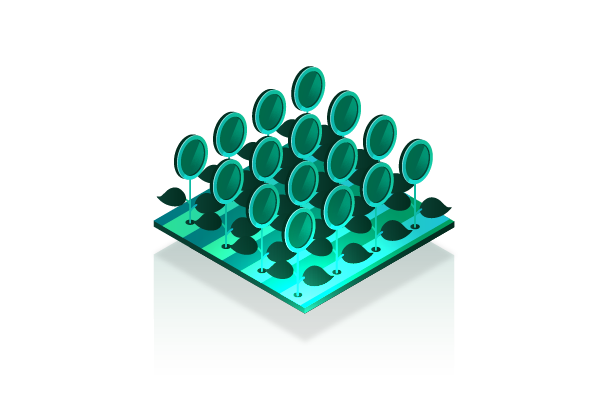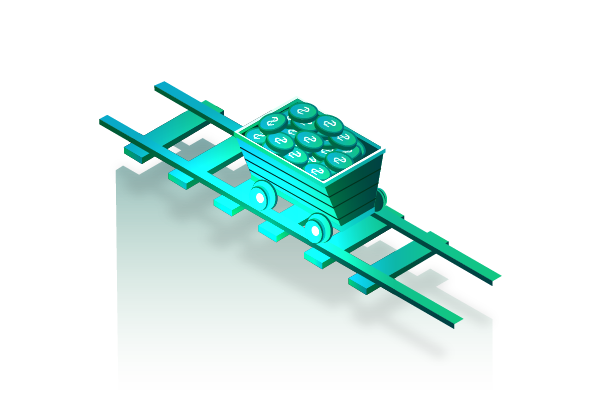In the fast-paced world of decentralized finance (DeFi), two buzzworthy terms often discussed are “yield farming” and “liquidity mining.” These two strategies have captured the attention of crypto enthusiasts and investors alike. While they share commonalities, they also possess unique characteristics that set them apart. In this comparative guide, we’ll dive into the world of yield farming vs. liquidity mining to provide a straightforward understanding of their distinctions, advantages, and potential risks. Whether you’re a newcomer embarking on your crypto journey or a seasoned investor seeking fresh opportunities, this article aims to offer a concise overview.
Yield farming and liquidity mining are both techniques used to earn rewards in the DeFi space. Yield farming typically involves providing liquidity to decentralized exchanges or lending platforms in exchange for tokens and fees. On the other hand, liquidity mining often focuses on incentivizing users to contribute their assets to a protocol by offering them native tokens or other rewards. Both methods can yield impressive returns, but they come with their own set of complexities and risks that individuals should be aware of before participating.
To sum it up, understanding the distinctions between yield farming and liquidity mining is crucial for anyone considering these DeFi strategies. While they both offer potential rewards, they involve different mechanisms and risks. Whether you lean towards yield farming or liquidity mining, it’s essential to do your research, comprehend the nuances, and exercise caution when navigating the ever-evolving landscape of decentralized finance.
Understanding Yield Farming

Yield farming is a significant concept in the decentralized finance (DeFi) ecosystem, where participants lend or stake their cryptocurrencies in a liquidity pool to facilitate trading on decentralized exchanges (DEXs). Here’s a deeper dive into its components:
Liquidity Provision
At its core, yield farming involves providing liquidity. Users deposit their cryptocurrencies into a pool, making them available for others to borrow or trade. These pools are essential for the functioning of DEXs, as they rely on user-supplied liquidity to enable asset trading.
Earning Rewards
In return for their deposited assets, liquidity providers earn rewards. These can come in various forms:
- Interest from Lenders: Similar to a traditional bank, users can earn interest by lending out their assets.
- Trading Fees: A portion of the trading fees generated from the DEX can be distributed to liquidity providers.
- Native Tokens: Some protocols issue their own tokens as rewards for participation, which can sometimes lead to substantial returns if the value of these tokens increases.
Risk and Return
The allure of yield farming is often the high returns it promises. However, these returns come with risks:
- Impermanent Loss: When the price of the deposited assets changes compared to when they were deposited, it might lead to a temporary loss.
- Smart Contract Risks: As yield farming protocols operate on smart contracts, any bugs or vulnerabilities can lead to loss of funds.
- Market Risks: The volatile nature of cryptocurrencies means the value of rewards can fluctuate dramatically.
Maximizing Returns
Yield farmers often move their assets around to different pools or strategies that offer the best returns. This involves constantly monitoring various factors like interest rates, token rewards, and pool stability.
Understanding and participating in yield farming requires a good grasp of cryptocurrency market dynamics, smart contract functionality, and risk management. While it offers the potential for high returns, it’s crucial for individuals to assess the associated risks and conduct due diligence on the protocols they wish to engage with.
Liquidity Mining Explained

Liquidity mining is a concept in the blockchain and decentralized finance (DeFi) space that involves users participating actively in a blockchain network’s ecosystem, primarily by providing liquidity to certain protocols or applications. In this process, users lock up their tokens in smart contracts. These smart contracts are automated agreements encoded on the blockchain that execute when predetermined conditions are met, ensuring a trustless and decentralized process.
The primary purpose of liquidity mining is to earn rewards. These rewards are usually in the form of the native tokens of the protocol to which the liquidity is provided. This incentivizes users to contribute their assets, as they receive a return on their investment in the form of these token rewards.
Liquidity mining programs are typically launched by DeFi projects to encourage users to provide liquidity. By doing so, they ensure that there’s enough capital within their ecosystems for various operations like lending, borrowing, or exchanging assets. This contribution of liquidity by users is crucial for the smooth functioning and growth of DeFi protocols, as it enhances the overall efficiency and stability of the market within that specific blockchain network.
Thus, liquidity mining is a fundamental aspect of DeFi, promoting user participation, network growth, and the decentralization of financial services.
Also Read: Blockchain For Beginners: First Steps Towards Decentralization
Key Differences Between Yield Farming and Liquidity Mining

Yield farming and liquidity mining are two popular strategies in the decentralized finance (DeFi) space, each with unique characteristics and purposes:
Purpose and Incentives
- Yield Farming: The core purpose of yield farming is to earn a return on capital by providing liquidity to decentralized exchanges (DEXs) or other types of lending pools. It’s akin to earning interest in a traditional bank, but in a decentralized environment. The primary incentive for yield farmers is the fees or interest generated from the liquidity they provide. These fees are typically a percentage of the trading volume on the DEX or interest from borrowers in lending pools. Yield farming may also involve moving assets around different protocols to chase higher yields, often referred to as “crop rotation.”
- Liquidity Mining: Liquidity mining is a more active participation strategy in the DeFi ecosystem. It’s not just about providing liquidity; it’s about supporting a specific project or protocol. Participants, known as liquidity miners, often receive new tokens as a reward for their contribution. These tokens represent a stake in the project and can appreciate in value if the project does well. The purpose is dual: to bootstrap liquidity for a new project and to distribute tokens to a wide user base, often for governance purposes. Incentives are typically higher than yield farming due to the added risk of investing in newer projects.
Risk Profile
- Yield Farming: The risk in yield farming comes from market volatility and impermanent loss, particularly in volatile asset pairs. However, because yield farming often involves more established and stable platforms, the overall risk is generally perceived to be lower compared to liquidity mining. The platforms used in yield farming usually have a longer track record and a larger user base, providing a certain level of reliability. Despite this, risks remain, and farmers need to be vigilant about the protocols they choose to interact with.
- Liquidity Mining: The risks in liquidity mining are notably higher due to several factors. First, many liquidity mining projects are new with shorter track records, which may increase the risk of bugs, hacking, or outright scams. Additionally, the value of the rewards (often the project’s native tokens) is highly volatile and can decrease significantly if the project doesn’t succeed. This makes the strategy riskier but also potentially more rewarding if the project takes off.
Asset Flexibility
- Yield Farming: In yield farming, participants have a wide range of options regarding where to invest their capital. They can choose from various pools offering different asset pairings and strategies. This flexibility allows farmers to diversify their investments and manage risk more effectively. They can quickly move their assets to different pools or platforms to optimize their returns based on changing market conditions.
- Liquidity Mining: Liquidity mining often requires participants to lock up specific assets prescribed by the project, usually the project’s own tokens or other tokens integral to the protocol. This can limit investors’ ability to quickly move their capital around and diversify their holdings. The specific assets required for liquidity mining may also be more volatile or less liquid than the more established assets often used in yield farming.
Earnings Potential
- Yield Farming: While the earnings from yield farming are generally more consistent, they are usually lower compared to the potential high rewards of successful liquidity mining projects. The income from yield farming comes from transaction fees on DEXs or interest payments, which are relatively stable but don’t offer the exponential growth potential of holding a successful new token.
- Liquidity Mining: The main draw of liquidity mining is the potential for high rewards. If the project succeeds, early liquidity providers can earn significant returns, especially if the value of the rewarded tokens increases dramatically. However, this higher potential return comes with a higher risk, as the value of these tokens is highly uncertain and can fluctuate widely based on the project’s success or failure.
Duration
- Yield Farming: Yield farming can be more fluid and flexible in terms of duration. Farmers can typically enter and exit positions relatively freely, allowing them to respond to changes in the market or shift strategies quickly. This makes yield farming more suitable for those who prefer a more active management style or for taking advantage of short-term opportunities.
- Liquidity Mining: Liquidity mining often involves a more extended commitment. Projects may require participants to lock their assets for a certain period to qualify for rewards or have rewards vest over time. This can tie up capital and make it less accessible. However, this longer-term commitment can also align the interests of liquidity providers with the long-term success of the project, potentially leading to more substantial and more sustained rewards if the project is successful.
In summary, yield farming and liquidity mining each offer unique opportunities and risks. Yield farming is generally more stable and flexible, while liquidity mining offers higher potential rewards but at a higher risk and often requires a longer-term commitment. The right strategy depends on an individual’s risk tolerance, investment goals, and time horizon.
Evaluating Risk and Rewards
When evaluating whether to engage in yield farming or liquidity mining, understanding your personal investment profile is crucial. Yield farming typically appeals to conservative investors due to its perceived stability and lower risk profile, offering more predictable returns. It’s often seen as a way to earn steady, albeit sometimes modest, rewards through providing liquidity in decentralized finance (DeFi) protocols.
On the other hand, liquidity mining might attract individuals with a higher risk appetite. It’s known for potentially offering higher rewards but comes with increased risk and uncertainty. Liquidity mining often involves providing liquidity to newer or less established pools or protocols, which might offer higher incentives to compensate for the greater risk.
In both strategies, factors such as impermanent loss, protocol security, and token volatility are critical considerations. Diversifying across different protocols and continuously monitoring market conditions and protocol updates are common practices to manage risk. Ultimately, the choice between yield farming and liquidity mining should align with your risk tolerance, investment goals, and understanding of the DeFi space.
Also Read: Utility Token vs Security Token: Breaking Down The Essential Differences
Diversification and Balance
In the realm of decentralized finance (DeFi), yield farming and liquidity mining represent two popular strategies for cryptocurrency enthusiasts seeking to increase their holdings. Both methods involve the user providing some form of capital to a DeFi protocol in exchange for rewards, usually in the form of additional cryptocurrency.
Yield farming is often associated with lending out one’s tokens to gain interest, while liquidity mining typically involves providing liquidity to a pool and earning tokens in return. Each has its unique risks and rewards: yield farming can be more predictable but generally offers lower returns, whereas liquidity mining might offer higher incentives but comes with the risk of impermanent loss.
Given the distinct characteristics of each strategy, many users choose not to rely exclusively on one. Instead, they adopt a diversified approach, balancing their participation between yield farming and liquidity mining. This allows them to spread their risk across different platforms and types of investments while tapping into various income streams. Diversification is a key principle in investment that can help manage risk and return, especially in the volatile world of cryptocurrencies. By not putting all their eggs in one basket, users can potentially mitigate the downsides of one strategy by gains in another. This balanced approach aligns with the broader investment strategy of not being overly reliant on a single source of return and being prepared for various market conditions.
Conclusion
In the world of DeFi, yield farming and liquidity mining are two compelling strategies that offer opportunities to earn passive income and participate in blockchain ecosystems. While yield farming emphasizes liquidity provision on DEXs and provides more predictable returns, liquidity mining focuses on actively supporting specific projects with the potential for higher rewards but increased risk.
As a prudent investor, it’s crucial to carefully consider your risk tolerance, goals, and the specific projects you want to engage with before choosing one or both of these strategies. Remember that diversification and a balanced approach can be your allies in navigating the dynamic world of decentralized finance. Whether you opt for yield farming, liquidity mining, or a combination of both, always conduct thorough research and stay informed to make informed decisions in the DeFi space.
Disclaimer: The information provided by HeLa Labs in this article is intended for general informational purposes and does not reflect the company’s opinion. It is not intended as investment advice or recommendations. Readers are strongly advised to conduct their own thorough research and consult with a qualified financial advisor before making any financial decisions.

Joshua Soriano
I am Joshua Soriano, a passionate writer and devoted layer 1 and crypto enthusiast. Armed with a profound grasp of cryptocurrencies, blockchain technology, and layer 1 solutions, I've carved a niche for myself in the crypto community.
- Joshua Soriano#molongui-disabled-link
- Joshua Soriano#molongui-disabled-link
- Joshua Soriano#molongui-disabled-link
- Joshua Soriano#molongui-disabled-link


Pingback: Liquidity Mining Explained: Marketing Opportunities in Crypto’s Yield Farming – A 2025 Guide to Maximizing DeFi Returns – DisruptDigi